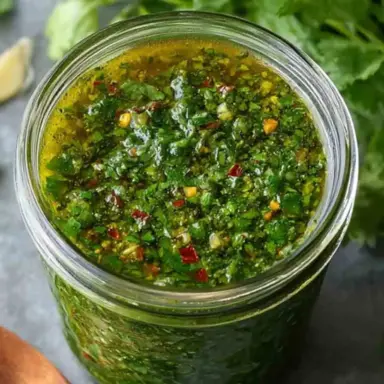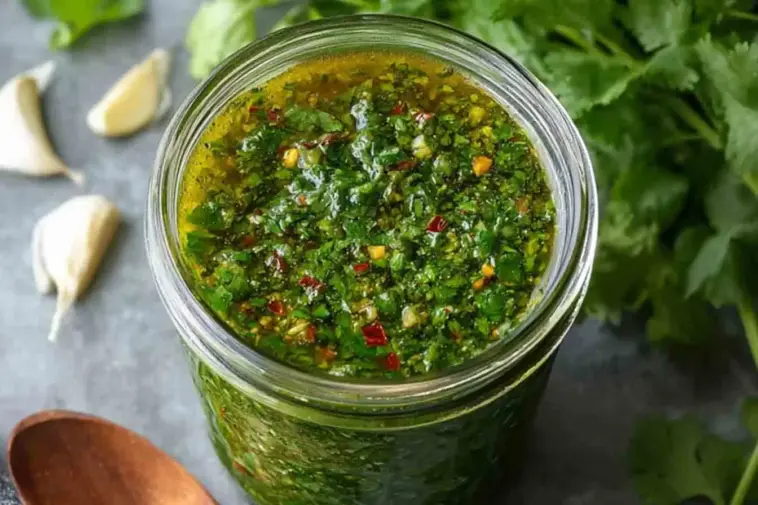Cilantro chimichurri is a vibrant, herbaceous green sauce made with fresh cilantro, garlic, olive oil, vinegar or citrus juice, and a touch of chili heat. It’s a bold and zesty condiment that brings brightness and depth to everything from grilled meats to roasted vegetables, tacos, grain bowls, and more.
Traditionally, chimichurri hails from Argentina and Uruguay, where it’s made with parsley, garlic, olive oil, oregano, and red wine vinegar. It’s typically served as an accompaniment to grilled steaks (asado), a staple in South American cuisine. Cilantro chimichurri is a flavorful spin on that classic recipe, swapping parsley for cilantro to introduce a citrusy, slightly peppery twist that plays beautifully with spicy, smoky, and grilled foods.
While it’s not “authentic” in the strictest sense, this version has carved a place in fusion and modern global cooking. You’ll find it in food trucks, Latin-inspired restaurants, and home kitchens alike. It’s especially popular with those who enjoy bolder, tropical flavors often found in Caribbean, Mexican, or Peruvian cuisine.
Tip: Knowing your sauces can elevate your cooking game. Chimichurri is part of a broader family of herb-based condiments, like pesto and salsa verde, each with their own cultural roots—but this cilantro variation stands out for its fresh intensity and fiery edge.
Origins & Cultural Inspiration Behind the Sauce
Classic chimichurri originated in Argentina and Uruguay, typically used as a marinade or finishing sauce for grilled meats. The original sauce—parsley-based, with garlic, oregano, vinegar, and olive oil—was rustic, punchy, and essential in South American grilling culture.
As culinary borders blurred, chefs and home cooks began experimenting with herbs beyond parsley. Cilantro, native to many Latin American and Caribbean cuisines, became a natural fit. Its grassy, citrus-forward profile brings new life to the traditional formula, especially when paired with lime or red wine vinegar.
Today, cilantro chimichurri is embraced in global kitchens as a versatile, flavor-packed sauce. From high-end restaurants drizzling it over seared seafood to home cooks spooning it on tacos or roasted cauliflower, it has found a modern identity beyond its roots—without losing its bold, herb-driven soul.
Why You’ll Love This Cilantro Chimichurri Recipe
If you’re craving something bold, fresh, and fast—this is it. Cilantro chimichurri is tangy, garlicky, and spicy, with a vibrant green color and taste that transforms any dish into something exciting.
It’s also ridiculously versatile. Spoon it over grilled steak or chicken. Toss it into rice or quinoa bowls. Use it as a dipping sauce for empanadas, a salad dressing base, or a topper for roasted vegetables. The possibilities are endless.
The best part? It’s quick to make and doesn’t require any cooking. A few pulses in a food processor—or even a quick chop and stir—is all you need. Plus, it’s naturally vegan and gluten-free, making it friendly for almost every diet.
Whether you’re looking to elevate a weeknight dinner or impress guests with something bright and zippy, this cilantro chimichurri delivers every time.
Ingredients Breakdown & Substitutions
Let’s break down what goes into this vibrant sauce and why each ingredient matters:
-
Fresh Cilantro: The star of the show. It adds citrusy, peppery brightness that defines this version of chimichurri.
-
Garlic Cloves: Adds pungency and depth. Don’t skimp—it’s key to that signature punch.
-
Red Wine Vinegar or Lime Juice: The acid balances the richness of the oil and brings out the herbal notes. Lime adds a zesty Mexican flair.
-
Olive Oil: Acts as the body of the sauce and helps carry the flavors. Use extra virgin for best results.
-
Red Pepper Flakes or Jalapeño: Brings heat. Use chili flakes for convenience, or fresh chopped jalapeño for bold, green heat.
-
Salt & Black Pepper: Enhances and rounds out the flavors.
Substitutions:
-
Swap cilantro with a mix of parsley and mint if you’re not a fan.
-
Use lemon juice instead of vinegar for a lighter, fruitier tang.
-
Avocado oil is a mild alternative to olive oil.
-
Add shallots for a mellow oniony note if desired.
Important: Always use fresh herbs. Dried cilantro won’t give the vibrant flavor or texture you’re after. This sauce depends on brightness—freshness is non-negotiable.
How to Make Cilantro Chimichurri (Step-by-Step)
Making this sauce is refreshingly simple and can be done two ways: with a food processor or by hand.
Step-by-step:
-
Rinse and dry your cilantro thoroughly (including some tender stems).
-
Add cilantro, garlic, vinegar or lime juice, chili, salt, and pepper to your food processor.
-
Pulse a few times to chop everything roughly.
-
Slowly drizzle in olive oil while pulsing until combined—but still slightly chunky.
-
Taste and adjust acidity or salt to your liking.
Hand-chopped version: Finely mince the cilantro and garlic, then mix with vinegar, oil, chili, salt, and pepper in a bowl.
Optional Texture Tip: Blend less for a rustic, chunky texture; blend longer for a smoother, more emulsified sauce.
Spice control: Start with a little chili and adjust based on your heat preference.
Storage:
-
Store in a glass jar or airtight container in the fridge for up to 5–7 days.
-
You can freeze leftovers in ice cube trays and thaw as needed.
Advertisement
Pro Tip: Let the sauce sit at room temperature for 15–30 minutes before serving. It gives the flavors time to meld and intensify beautifully.
Best Ways to Use Cilantro Chimichurri
One of the best things about cilantro chimichurri is just how versatile it is. This bright, zippy sauce works beautifully across cuisines and cooking styles. If you’ve made a batch, here are some irresistible ways to use it:
-
Over grilled meats: Drizzle it over steak, chicken thighs, lamb chops, or pork tenderloin for a flavor-packed finish. It especially shines on smoky or char-grilled meats.
-
Taco topping: Add a spoonful to carne asada, chicken tinga, or grilled veggie tacos for a fresh, herbaceous kick.
-
Rice and grain bowls: Stir it into quinoa or brown rice bowls, or use it to brighten up a Mediterranean-style grain salad.
-
Roasted vegetables: Toss roasted potatoes, sweet potatoes, cauliflower, or carrots with chimichurri for a zesty upgrade.
-
Sandwiches and burgers: Use it as a spread on ciabatta, paninis, or burgers instead of mayo or mustard.
-
Marinade for shrimp or tofu: Let your protein soak in cilantro chimichurri before cooking for bold, herbal depth.
Try this tonight: Grilled chicken + chimichurri + warm tortillas = a 5-star dinner with minimal effort.
Cilantro Chimichurri Variations & Add-Ins
Want to change things up? Here are a few creative and delicious variations:
-
Mint or basil: Add a handful for a twist that pairs beautifully with lamb or summer vegetables.
-
Avocado: Blend in ½ an avocado for a creamy, thicker version—amazing as a sandwich spread or dip.
-
Spicy kick: Use serrano or jalapeño peppers for extra heat. Roasted chiles work great too.
-
Chimichurri mayo: Mix with mayo to create a tangy burger or fry sauce.
-
Yogurt dip: Stir into Greek yogurt for a creamy, herby dip perfect for grilled veggies or pita.
Don’t be afraid to experiment. The base recipe is forgiving and easily adaptable depending on your mood or meal.
How to Store and Freeze Cilantro Chimichurri
Freshly made cilantro chimichurri can be stored in the fridge for up to 1 week in a sealed glass jar or container. The flavors will deepen over time, often tasting even better the next day.
To freeze, spoon the chimichurri into ice cube trays and freeze until solid. Transfer the cubes to a zip-top freezer bag and store for up to 2–3 months. You can thaw just what you need at a time.
After thawing, the sauce may separate slightly. Just give it a stir or pulse in a blender to bring it back together.
Note: A slight color change (darker green or olive hue) is normal and doesn’t affect the flavor. If it smells fresh and vibrant, it’s still good to go.
Expert Tips to Get It Just Right
Crafting a great chimichurri isn’t complicated, but a few small touches can elevate it to next-level delicious:
-
Use good-quality olive oil. This is one of the main ingredients—make sure it tastes smooth and fresh.
-
Always taste and adjust. Vinegar and salt levels vary, so balance the tang to suit your palate.
-
Don’t over-blend. Chimichurri should have texture. Pulse it just enough to chop the herbs and garlic.
-
Hand-chop garlic if not blending. This prevents it from being overpowering or bitter.
-
Zest for brightness. A bit of lemon or lime zest adds extra sparkle and complexity.
-
Too bitter or sharp? Add a pinch of sugar or a touch more oil to mellow it out.
Pro Insight: The best chimichurri has layers—herby, acidic, spicy, and garlicky. Don’t be afraid to tweak it until it sings.
FAQs About Cilantro Chimichurri
What does cilantro chimichurri taste like?
It’s fresh, tangy, garlicky, and just a little spicy. The cilantro gives it a citrusy brightness, while the vinegar and garlic punch through with intensity. It’s bold but incredibly balanced.
Can you use parsley instead of cilantro?
Yes! You can substitute part or all of the cilantro with flat-leaf parsley. The flavor will be closer to traditional chimichurri—less citrusy, more grassy.
Is cilantro chimichurri spicy?
It can be, depending on how much chili you use. Red pepper flakes or jalapeño add heat, but you can easily adjust the amount to your taste.
Can you freeze chimichurri sauce?
Absolutely. Freeze it in ice cube trays for easy single servings. Just thaw and stir before using.
What dishes pair best with cilantro chimichurri?
It’s perfect for grilled chicken, steak, shrimp, lamb, tacos, roasted veggies, rice bowls, or even as a dip for bread or empanadas.

Cilantro Chimichurri
Equipment
- Food processor or blender
- Measuring spoons
- Cutting board and knife
- Airtight jar or container for storage
Ingredients
- 1 bunch fresh cilantro about 1 cup packed
- 2 –3 garlic cloves
- 2 tablespoons red wine vinegar or lime juice
- ½ cup extra virgin olive oil
- ½ teaspoon red pepper flakes or 1 chopped jalapeño
- ½ teaspoon salt
- ¼ teaspoon black pepper
Instructions
- Wash and pat dry the cilantro. Trim any thick stems.
- Add cilantro, garlic, vinegar, red pepper flakes, salt, and pepper to a food processor.
- Pulse several times until finely chopped.
- With the processor running, slowly stream in the olive oil until combined but slightly chunky.
- Taste and adjust seasoning if needed.
- Let sit 15–30 minutes before serving for best flavor.
- Store in an airtight container in the fridge for up to 1 week.
Notes
- For a creamier version, blend in half an avocado.
- Don’t over-blend — a little texture is ideal.
- To freeze, portion into ice cube trays and transfer to a freezer bag once solid.
Nutrition
Conclusion: Why Cilantro Chimichurri Deserves a Spot in Your Kitchen
Cilantro chimichurri is more than just a sauce—it’s a flavor bomb waiting to elevate your meals. With its bold freshness, effortless prep, and endless versatility, it’s a recipe that delivers every time.
Don’t overthink it—grab some fresh cilantro, blend it up, and spoon it generously over your next dinner. Whether it’s grilled chicken, roasted veggies, or even scrambled eggs, this green goodness makes everything taste like summer.
Try it tonight—you’ll wonder how you cooked without it.

